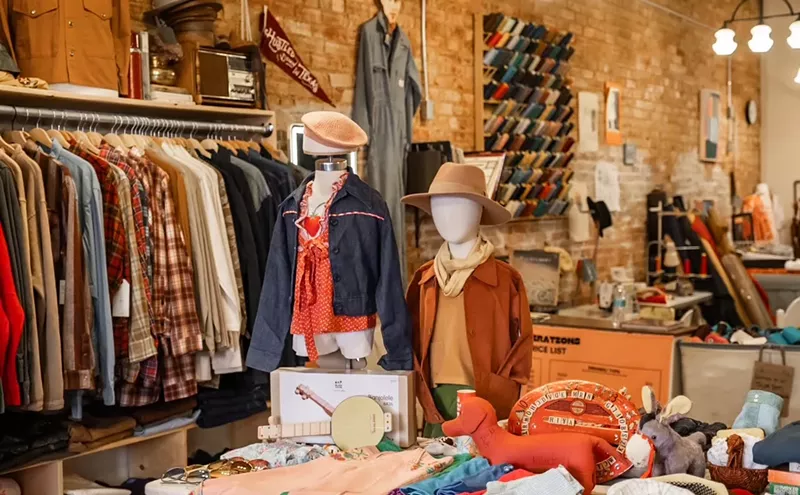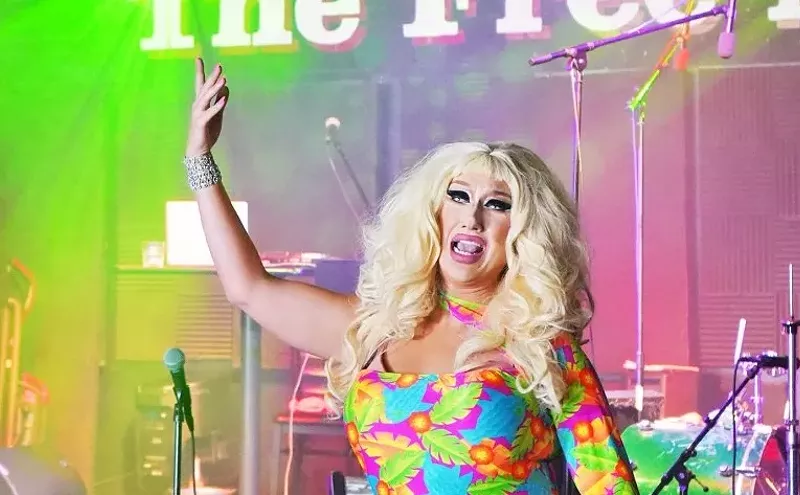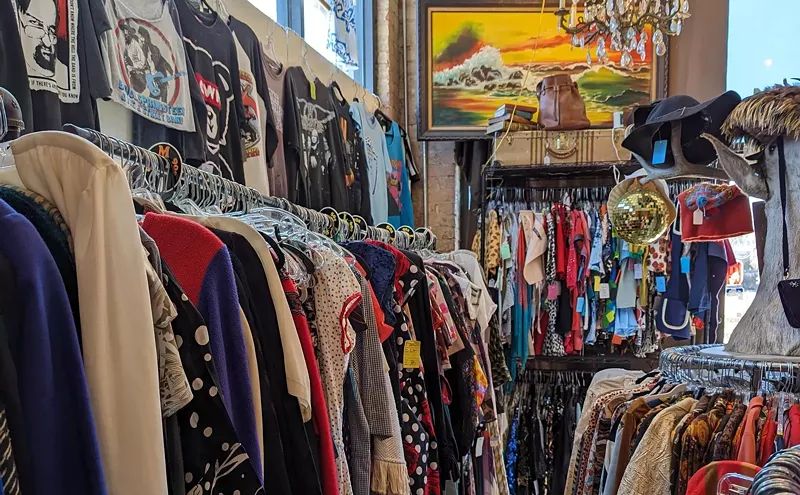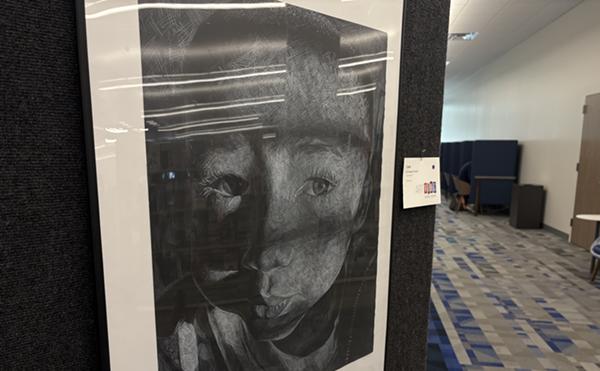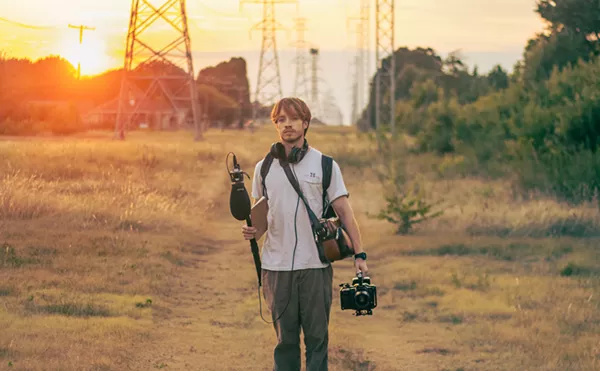The answer, of course, is that we would fetishize the written word as we now do art. Absent the odd wandering minstrel, the vox populi would have none of what Hughes calls a "sense of literature," certainly no more than they now have a sense of painting. This state of affairs would create harrumphing and manifestoes about the death of culture and a sense of snide superiority on the part of the French. It would also create civic embarrassment. Cities eager to advertise their sophistication would buy or accept as gifts the occasional second-rate manuscript, and would build great limestone mausoleums like the one at the corner of Ross and Harwood to house their prizes.
The public would shuffle by in single file, read a page or two, genuflect, and leave the building without being significantly enriched, which is to say educated. How could they be? In theory, the literary museum would house a sort of survey course, a representative cross-section of periods and genres, but thanks to ever-escalating prices and limited museum funds, the viewing public would get something far more accidental. As for the literature of the very recent past, well, if our word museum worked like most art museums, that would be the area in which they served the public most poorly of all. In an effort to be au courant, the curators would bring in examples of the latest market craze: self-help. Celebrity fluff. Memoirs. E-books. And the public, having been fed such tripe and cut off from centers where important books are bought and sold and read and easily inspected, might even believe silly slogans like Literature is Dead.
And so it is with contemporary art. At your average regional museum, you can't get past the fetishizing and the accidental survey and the we-want-to-be-hip-too bias to get a feel for the state of current American painting. Fortunately, the Modern Art Museum of Fort Worth has never been your average regional museum. Its current show, titled Wayne Thiebaud: a Paintings Retrospective, is the kind of in-depth, narrowly focused exhibition it has long preferred, and you can glean more about the state of American painting from it than from several years of dropping in on, say, the Dallas Museum of Art. On view through January 14, 2001, the show presents 100 works from the California painter's last 45 years--a veritable banquet of works of varying strength. Better still, the show is accompanied by a catalog with intelligent and readable critical essays penned by the show's curator, the Fine Arts Museums of San Francisco's Dr. Steven Nash, and by New Yorker writer Adam Gopnik, late of "Letter from Paris" fame.
The result is a rare opportunity to view the oeuvre of an important contemporary artist in depth. Forty years after he made his big splash in the art world, Wayne Thiebaud is still turning out California landscapes and teaching the occasional class at UC Davis. At 80, Thiebaud has lived and painted through the American half-century, and he has seen it all. He knew the abstract expressionists. He participated in pop. He witnessed the art world's slide into fashion victimhood, increasingly faddish and short-lived cycles of The Next Great Movement: earthworks, graffiti, neo-expressionism, neo-geo, film stills, pickled sheep, and so forth. He's been hot, and he's been cold, and through it all he's remained true to his own personal vision, singing I-gotta-be-me with more conviction than Tony Bennett ever managed.
The accompanying catalog suggests the source of this remarkable level-headedness. Thiebaud was born into a line of Swedes and Mormons who went West; his father, an inventor and jack of several trades, moved the family to Arizona and California and Utah during the Depression. As a teenager, Thiebaud took up cartooning after breaking his back playing sports, pursuing this passion even in the Army, where he did a comic strip for the base newspaper and drew maps. As a young man, Thiebaud held a variety of commercial art jobs, including illustrating movie posters and working as an apprentice illustrator at Disney, where, Gopnik tells us, it is said Thiebaud could draw Popeye simultaneously with his right and left hands.
In other words, not only was Thiebaud a largely self-taught draftsman of considerable talent, but he had the perfect background for a late-20th-century painter. Thiebaud was 30 when he first got the notion to become a "serious" painter, pursuing credentials at San Jose State College and then California State College at Sacramento. In the '50s he exhibited a few canvases in and around the Bay area, but, feeling the pull of New York, did several stints in the post-war world's art capital. Naturally enough, he fell under the influence of abstract expressionism, meeting and befriending figures such as Willem de Kooning and Franz Kline.
These influences are apparent in the show's early canvases, especially works such as "Cigar Counter" (1955) and "Ribbon Store" (1957). Yet Thiebaud was never quite one of them. A modest man, Thiebaud never seems to have shared the ab-ex taste for bombast or their fondness for grand, tragic-historic themes. Thiebaud composed elegies not to the Spanish Republic but to ribbon shops and pinball machines. True, they were deadly serious, lacking the humorous touch of Thiebaud's later work. And Thiebaud did take some ab-ex lessons to heart. "I had been put off by the churchy feeling of a lot of New York painting, and I saw de Kooning was too," Thiebaud told Gopnik. "He disabused me of it, and, as much as anyone, suggested to me that painting was a lot more important than art." Back in the studio, Thiebaud crossed de Kooning's painterly reductivism with his own preferred subject matter--everyday Americana--and created something utterly his own. In interviews, Thiebaud recalls the process: "I'd worked in food preparation...The way they line up food, sort of ritualistically, and I thought, 'Oh, I'll try that.' So I started painting these ovals for the plate and then put a triangle on it...then I realized I'd painted this row of pies and started laughing and said, 'Well, that's the end of me as a serious artist. Nobody's going to take this seriously.'"
Au contraire. It was as though the California painter had a hot line to the zeitgeist, and the New York art establishment, tired of the forced heroics of ab ex, fell in love. Thiebaud worked out his fast-food, pop-culture iconography at more or less the same time several of his contemporaries reached similar conclusions; thus, Manhattan galleries were full of Jasper Johns' flags and targets, Claes Oldenburg's household-object sculpture, and Andy Warhol's soup cans. Together, the critics called them "pop" artists, a label that Thiebaud grew to hate. A number of his champions, including Dr. Nash, seem overly eager to humor the artist on this point, suggesting Thiebaud was never really a pop artist, since he didn't intend social criticism. (As if Warhol had anything against celebrity or mass production.) According to Gopnik, Thiebaud's work is comedy, but not satire, delivered with the reverence of Chardin, not the sarcasm of Duchamp.
Thiebaud and his admirers protest too loudly and somewhat disingenuously, for if Thiebaud is a connoisseur of kitsch rather than a critic, the distinction is one of tone rather than substance. The very essence of Thiebaud's still lifes is their keen sense of, and delight in, the absurd. If his "pop" work from the '60s doesn't go out of its way to make life seem unreal, it may be because he recognizes the surreality of the everyday--to borrow words that Thiebaud uses frequently, the "goofy," odd nature of everyday "ritualism." The work is simple, abstract, recognizable, vernacular, thought-provoking: in short, pop at its best. Not to mention beautiful. Thiebaud's paint-handling is more luscious than the fatty confections he paints. His colors are pure and vibrant. Even his white backgrounds vibrate; in Thiebaud's work, white is a color as rich, varied, suggestive, and spellbinding as anything available from an artist's tube.
There is something to be gleaned, though, from Thiebaud's queasiness at being associated with pop. His real objection seems to be grounded in his fierce individualism, in what Gopnik identifies as his "sturdy refusal to let any artist succumb to a label," as well as in an understandable distaste for art-world marketing. In one of the most enlightening comments in Gopnik's essay, Thiebaud complains that the pop art movement had "some of the aspects of a 'racket.'" Perhaps in part as a reaction against the machine, by the mid-'60s, Thiebaud had turned to one of the squarest modes then available in art: painting the human figure.
Nash recounts Thiebaud's struggles with the human form. "I think an artist's capacity to handle the figure is a great test of his abilities," Thiebaud says. And thank heaven for his perseverance, for the figure painting is perhaps the strongest genre in Thiebaud's expansive portfolio. Many critics have disliked the work, complaining that Thiebaud has little feeling for his subjects; even Dr. Nash, the show's curator, seems less than enamored of the portraits, describing them as "remote" and as "direct extensions of the still lifes." Yet works such as "Portrait of Sterling Holloway" contain amazing psychological acuity. And 35 years after they were painted, others seem startlingly prescient. If we didn't know it then, the past two decades have brought home just how fungible people are, as isolated and profoundly detached as in "Five Seated Figures" or "Two Seated Figures." In the mid-'60s portraits, Thiebaud manages once again to paint with dazzling technical skill, and at the same time, to distill the spirit of his age without trying to do anything of the sort.
As paintings like "Orange Grove" (1966) show, even as Thiebaud explored the deli and the human figure, he was dabbling in landscape, and by the late '60s, it became an increasing preoccupation. Dr. Nash finds something telling in a series of late-'60s landscapes, in which Thiebaud uses the techniques of color-field painting to create hills and bluffs and other recognizable landscape forms, thereby serving up a "cheeky parody" of a form of non-objective painting beloved by the East Coast art establishment. According to Nash, Thiebaud is poking fun at the art world's preference for abstraction over his own mode, representative painting.
Thiebaud made his commitment to painting recognizable forms early on, as a direct result of his exposure to abstract expressionism, and he has never wavered. According to Nash, Thiebaud believed the New York School had "pursued their particular formal and expressive issues to final resolutions that are difficult to build on"; to borrow a line from the musical "Oklahoma," they'd "gone about as fer as they can go." The future of painting was the past: representation, realism, the paths illuminated by the likes of Velázquez and Vermeer, a field of possibilities that "cannot be exhausted."
In the early '70s, Thiebaud turned his back on the still lifes and the portraits, and in a very real sense on New York, buying a small house in San Francisco and beginning anew as a painter primarily of cityscapes. It was a natural progression for one with such a finely honed appreciation for the absurd, from the peculiarities and rituals of food prep to streets that buckled and plunged and cars that looked as if they must have suspended gravity. His San Francisco cityscapes play up these oddities, toying with perspective, sometimes appearing to stand streets vertically alongside buildings and hills, like topographic maps folded at 45- or even 90-degree angles.
Once again, he reduced the forms to their essence, to rectangles of building and stripes of highway, to the very edge of abstraction, but never beyond recognition.
The work was masterful and painterly, bordering here on folk art, there on surrealism, and now and then on the pictograph, yet always recognizable as San Francisco and as Thiebaud. And it was largely ignored by the East Coast establishment that once loved him. In a footnote to his essay, Dr. Nash discusses the problem: "He has received over the years a fair amount of the critical cold shoulder, which has to do in part with the traditionally difficult times that West Coast artists have in East Coast media and also with ingrained modernist biases against realism per se."
True enough, as far as it goes. But Nash uses the wrong Latin phrase, and thereby misses the biggie: The problem isn't realism per se so much as realism in rem. Every age has its hierarchy of painting subjects, and post-Mondrian, the 20th was a very bad century for landscape painters. To be sure, everyone dallies in it, and a few brave or lucky souls--fellow Californian Richard Diebenkorn springs to mind--have even managed to build careers at the intersection of landscape and abstraction. But, by and large, to specialize in contemporary landscape painting is to condemn oneself to art-world obscurity. Since the '30s, the cityscape is no better a career option; ditto for regionalism.
To his credit, Thiebaud never gave a rat's rear end. He taught. He painted. He had shows. And over 30 years, he has created a body of work that is a paean not only to California but to neo-Emersonian individualism. He ventured out to the 'burbs, creating lyrical masterpieces such as "Freeways" (1975-1979) and "Urban Freeways" (1979), songs both of himself and of American car culture. He continued to evolve, in the late '90s striking out in yet another vein: rural landscapes, at once vaguely recognizable and utterly unlike anything you've seen. Large canvases such as "River and Farms" (1996) seem to depict fantastic alluvial plains as you might see them from a prop plane. They draw you in through obvious devices: the river leading into the picture, the luminous color. Thus lured, you begin to notice little oddities: trees and shadows at different angles, from different perspectives and times. He's mildly disorienting the viewer, presenting little puzzles of meaning and emotion, creating paintings resolutely modern and ancient, lightly covered and suavely impastoed.
His work sold well in galleries and at auction, appreciating in the eyes of all but the art world's critical machinery. By the '80s and '90s, Thiebaud became, if not quite a neglected painter, at least one on whom the rap was that he had nothing more to say. For what, exactly, is the significance of one man's struggle with a quirky topography?
Plenty, and hopefully this show will stir some art-world revisionism. Thiebaud has placed his bets on the right side of historical wagering: Painting is more important than much of what passes for contemporary art. And at the end of the 20th century, Thiebaud's exploration of the image, especially of California farmland, can look like the only fertile ground left.




